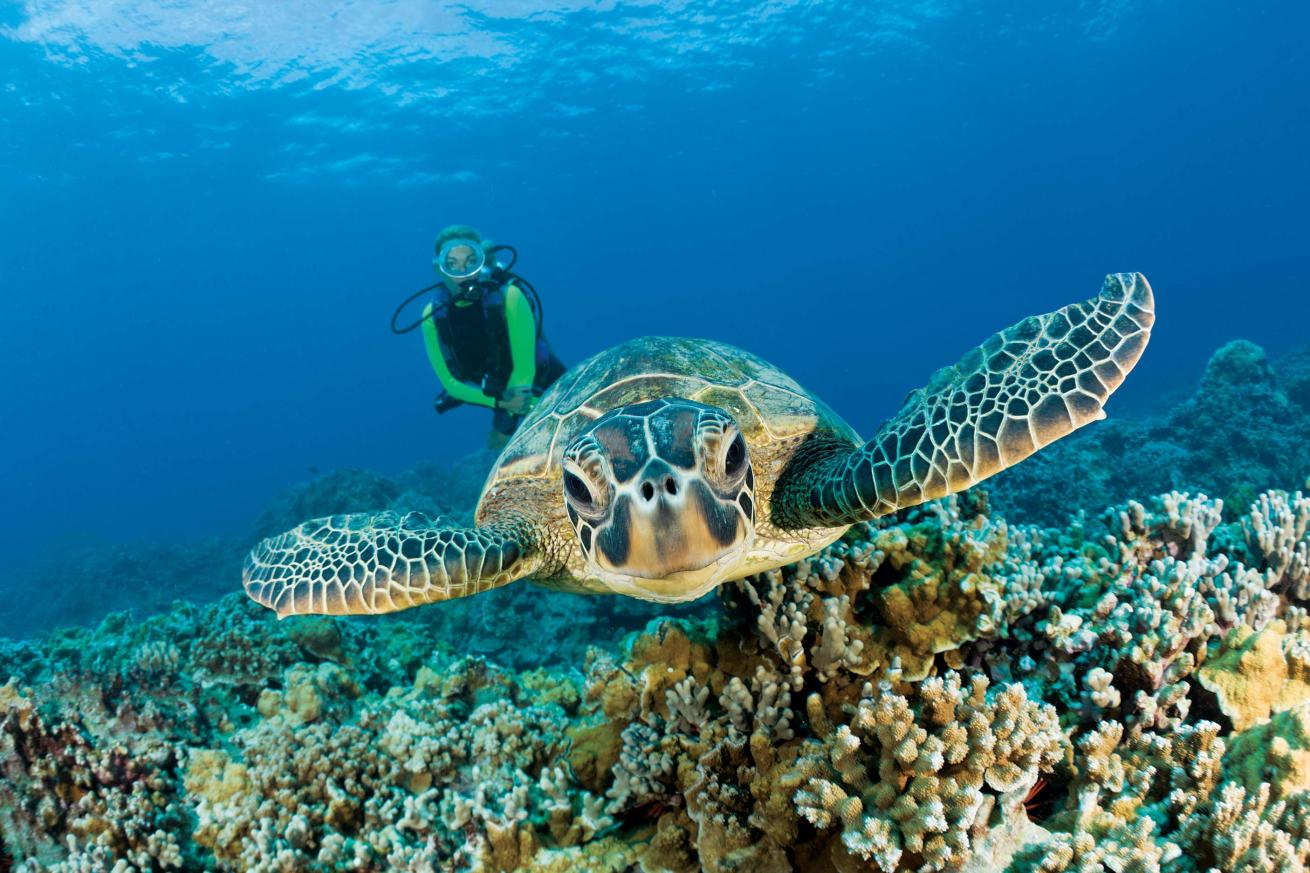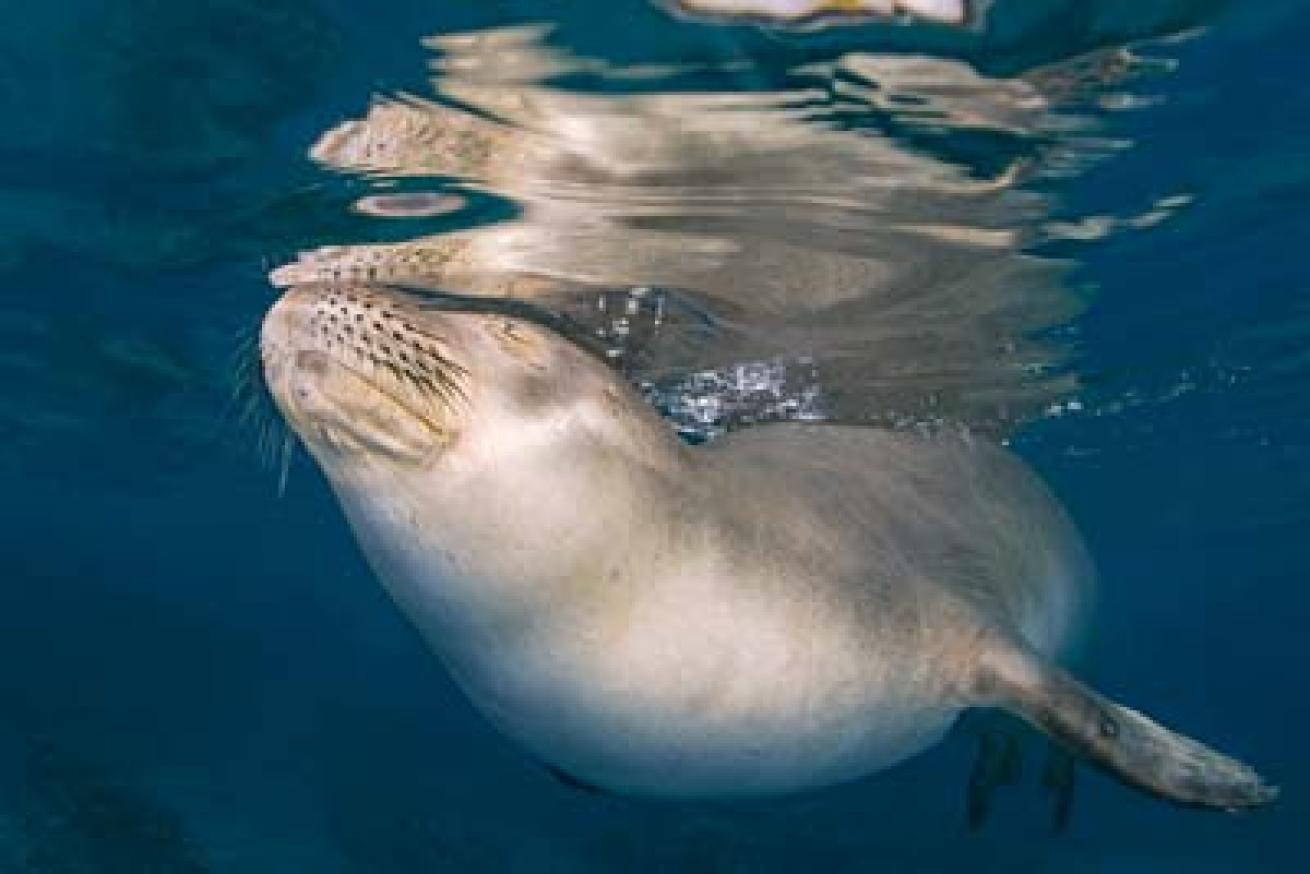Preserving the Northwestern Hawaiian Islands: It Takes an MPA

Green Sea Turtle
Reinhard Dirscherl
When Polynesian explorers followed the stars, winds, waves and sea creatures to the 1,500-mile-long Hawaiian archipelago — the world’s most isolated land mass — they found a chain of islands blessed with plentiful resources, and settled there around 400 A.D. The northwesternmost of these islands were surrounded by abundant sea life but lacked fresh water. Native Hawaiians revere these as ancestral islands. They see coral polyps as their earliest ancestors and the Northwestern Hawaiian Islands (NWHI) as the source of all life.
But other nations exploited the islands’ remoteness and lack of defenses, scouring the seas for whales, fish, lobster and pearls, and the beaches for Hawaiian monk seals and green turtles. Poachers killed albatross for meat and feathers, stripped seabird nurseries of eggs, and even scraped the rocks bare of guano for munitions and fertilizer.
By 1903, the devastation was so great that President Theodore Roosevelt sent the U.S. Marines to Midway Atoll to protect seabirds (as well as a trans-Pacific telegraph station). America’s presence on the NWHI had a split personality — most of the chain was set aside as the Hawaiian Islands Reserve (later the Hawaiian Islands National Wildlife Refuge), but Midway Atoll was a hub of military action during World War II and beyond. A channel dredged into its lagoon destroyed corals and permanently changed water flows. Airfields and bases stockpiled pollutants like fuel, some of which seeped into lagoons.

Yet a team of scientists from the University of Hawaii and elsewhere recently called the NWHI a global example of coral-reef recovery from human-inflicted damage. Their study, published in the peer-reviewed online journal PlosOne in October 2011, found the islands’ reefs are now healthy due to changes in the way people treat the ecosystem. Barry Stieglitz, the U.S. Fish and Wildlife Service official who oversees the island archipelago’s two national wildlife refuges, agrees.
“There simply aren’t any ‘pristine’ or ‘completely healthy’ reefs,” Stieglitz said, “but the reefs in the NWHI are in pretty good shape.”
One milestone in the islands’ recovery was the 1976 Magnuson-Stevens Fishery Conservation and Management Act, which regulated commercial fishing. Soon afterward, the Navy began closing bases, depopulating the islands — which reduced human impacts — and cleaning up some pollution. Midway Atoll became a national wildlife refuge in 1988, and in 2006, President George W. Bush protected the entire island and coral reef ecosystems in the NWHI as the Papahānaumokuākea Marine National Monument, comanaged by the Fish and Wildlife Service, National Oceanic and Atmospheric Administration and State of Hawaii. Midway Atoll is the only part of the Papahānaumokuākea Marine National Monument open to public use, potentially including scuba diving in the future. (The island currently lacks the infrastructure for dive tourism, but refuge officials hope to open it to divers in the future.) Commercial fishing was phased out between 2006 and 2010.
Still, there is work to be done. Though the threatened Hawaiian green turtle and several endemic land-bird species are doing well, three keystone species have not rebounded: pearl oysters, spiny lobsters and endangered Hawaiian monk seals. Despite intensive work by the National Marine Fisheries Service, monk-seal numbers are declining. Seal pups are easily picked off by sharks, which gather at their nurseries, so managers are relocating sharks that target the pups.
The dredged corals at Midway’s lagoon have not regrown, but every where else Papahānaumokuākea’s reefs are hotbeds of biodiversity, including many species that exist nowhere else in the world. James Maragos, a coral reef ecologist who retired from USFWS in 2011, was chief investigator on two research expeditions to the islands and participated in several others. “There’s a huge number of undescribed species out there,” Maragos said. “It’s fantastic.”


Reinhard Dirscherl
When Polynesian explorers followed the stars, winds, waves and sea creatures to the 1,500-mile-long Hawaiian archipelago — the world’s most isolated land mass — they found a chain of islands blessed with plentiful resources, and settled there around 400 A.D. The northwesternmost of these islands were surrounded by abundant sea life but lacked fresh water. Native Hawaiians revere these as ancestral islands. They see coral polyps as their earliest ancestors and the Northwestern Hawaiian Islands (NWHI) as the source of all life.
But other nations exploited the islands’ remoteness and lack of defenses, scouring the seas for whales, fish, lobster and pearls, and the beaches for Hawaiian monk seals and green turtles. Poachers killed albatross for meat and feathers, stripped seabird nurseries of eggs, and even scraped the rocks bare of guano for munitions and fertilizer.
By 1903, the devastation was so great that President Theodore Roosevelt sent the U.S. Marines to Midway Atoll to protect seabirds (as well as a trans-Pacific telegraph station). America’s presence on the NWHI had a split personality — most of the chain was set aside as the Hawaiian Islands Reserve (later the Hawaiian Islands National Wildlife Refuge), but Midway Atoll was a hub of military action during World War II and beyond. A channel dredged into its lagoon destroyed corals and permanently changed water flows. Airfields and bases stockpiled pollutants like fuel, some of which seeped into lagoons.

Yet a team of scientists from the University of Hawaii and elsewhere recently called the NWHI a global example of coral-reef recovery from human-inflicted damage. Their study, published in the peer-reviewed online journal PlosOne in October 2011, found the islands’ reefs are now healthy due to changes in the way people treat the ecosystem. Barry Stieglitz, the U.S. Fish and Wildlife Service official who oversees the island archipelago’s two national wildlife refuges, agrees.
“There simply aren’t any ‘pristine’ or ‘completely healthy’ reefs,” Stieglitz said, “but the reefs in the NWHI are in pretty good shape.”
One milestone in the islands’ recovery was the 1976 Magnuson-Stevens Fishery Conservation and Management Act, which regulated commercial fishing. Soon afterward, the Navy began closing bases, depopulating the islands — which reduced human impacts — and cleaning up some pollution. Midway Atoll became a national wildlife refuge in 1988, and in 2006, President George W. Bush protected the entire island and coral reef ecosystems in the NWHI as the Papahānaumokuākea Marine National Monument, comanaged by the Fish and Wildlife Service, National Oceanic and Atmospheric Administration and State of Hawaii. Midway Atoll is the only part of the Papahānaumokuākea Marine National Monument open to public use, potentially including scuba diving in the future. (The island currently lacks the infrastructure for dive tourism, but refuge officials hope to open it to divers in the future.) Commercial fishing was phased out between 2006 and 2010.
Still, there is work to be done. Though the threatened Hawaiian green turtle and several endemic land-bird species are doing well, three keystone species have not rebounded: pearl oysters, spiny lobsters and endangered Hawaiian monk seals. Despite intensive work by the National Marine Fisheries Service, monk-seal numbers are declining. Seal pups are easily picked off by sharks, which gather at their nurseries, so managers are relocating sharks that target the pups.
The dredged corals at Midway’s lagoon have not regrown, but every where else Papahānaumokuākea’s reefs are hotbeds of biodiversity, including many species that exist nowhere else in the world. James Maragos, a coral reef ecologist who retired from USFWS in 2011, was chief investigator on two research expeditions to the islands and participated in several others. “There’s a huge number of undescribed species out there,” Maragos said. “It’s fantastic.”











